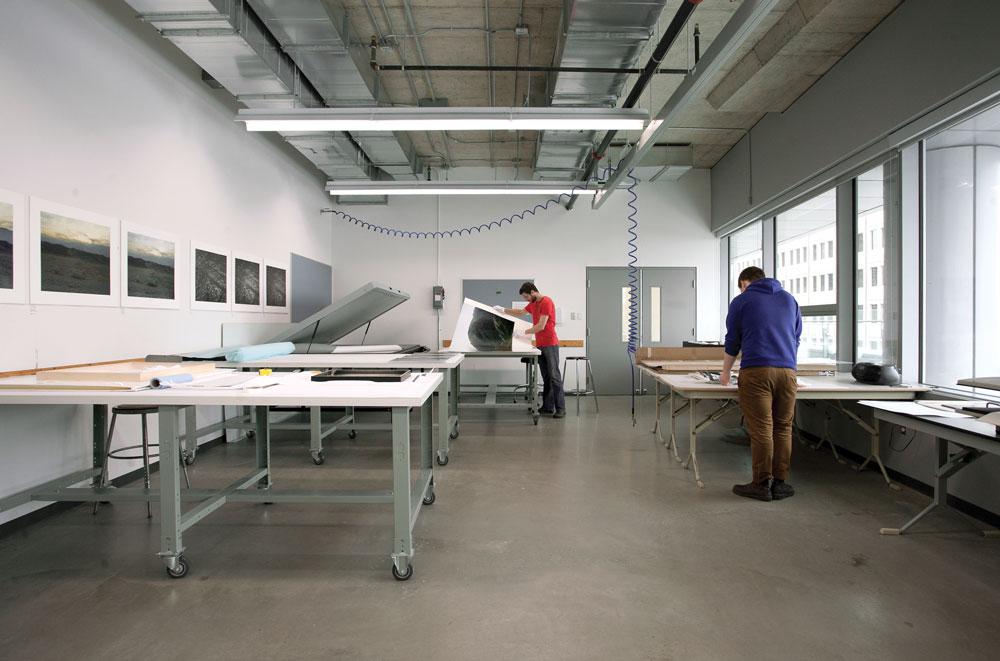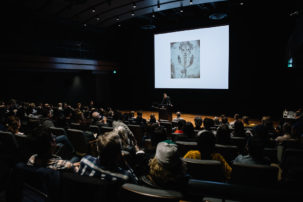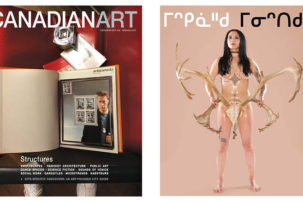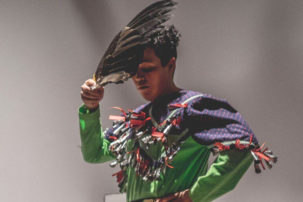The contemporary world of media turns on photography; we understand its applications and implications to be practically endless. This multiplicity directly affects those who study it. Potential students in the field (unlike, say, aspiring watercolourists) must grapple with what kind of photographer they want to be. Artist? Celebrity portraitist? Freelance journalist?
In this post, we highlight a range of some of the photography programs now available across Canada—from the technical to the conceptual, from those focused on production for walls to those centred on the web. All of the programs must respond to the biggest news in photography since the flashbulb: the end of analog production. They are debating how to handle this shift. Their decisions, including program size, location and area of concentration, may influence where you choose to enroll.
ATLANTIC
Mount Allison University Mount Allison University is in Sackville, New Brunswick: population 5,558. The town is small, the university is small and classes are small. The fine arts department generally consists of fewer than 25 first-year students. And then, within fine arts, there is photography: a department that recent graduate Graham Ereaux says “feels like a big family.” Faculty and students spend time together outside of class, keeping the educational atmosphere relaxed and discussions going. There are two professors: Thaddeus Holownia and Karen Stentaford, both practicing artists. Together, they run a program devoted to the traditional wet darkroom. The first year of the program is entirely analog. “The curriculum and teaching are based on the idea that everyone here uses analog to start with,” says Holownia. “We break down the techno-geek side of photography, this attitude that if you have great gear, you’ll be a great artist.” While students work concertedly on an independent study project in their last year, the program is quite self-directed all the way through: “I give them structure, but not assignments per se,” says Holownia. “They can bounce off the wall.”
Memorial University Photography at Memorial is taught at the university’s Grenfell Campus in Corner Brook, Newfoundland, as part of its BFA program in visual arts. Both digital and traditional darkroom practices are supported, with the emphasis placed on creating well-rounded artists versed in all aspects of art-making.
NSCAD University Located on and near the waterfront in Halifax, NSCAD University offers an interdisciplinary BFA program that encourages students to explore different modes of expression. The school’s conceptual history informs its teaching—photography is understood and taught as an art practice, rather than a commercial endeavour. Graduate students contribute to the strong academic component.
QUEBEC
Dawson College Part of Quebec’s CEGEP system of post-secondary education (which begins after the equivalent of Grade 11), Dawson is not a college in the way that many Canadians would expect. “We are not profit-oriented in any sense whatsoever,” says Roy Hartling, the program’s director. The program does not advertise and is not designed for out-of-province students—yet they enroll. “Our mandate is to take high school graduates and train them, in three years, to go out and work as photographers. They get a very specific education in visual imaging and visual communication.” Studios are open every day and evening—even during the summer—and the program is now completely digital, except for some black-and-white film processing and the historic processes taught as part of the program’s “history of photography” component. “Art directors and photo editors want to see the work of imagination and strong aesthetic insight,” Hartling notes. “It’s the students with strong, imaginative portfolios that stay in their minds.”
Université du Québec à Montréal “We don’t train photographers,” says UQAM visual and media arts professor Alain Paiement. “The point is what we do with the image.” It’s not possible to major in photography at the school—instead, the medium is taught as one aspect of image-making, with students required to understand photography’s relationship to video, installation and projection. Full analog facilities are provided, but students may choose to use digital technologies.
Concordia University Photography students at Concordia have access to some of the best digital and analog facilities in the country—from 44-inch printers to a full-colour darkroom—as well as a diverse faculty of widely recognized artists and art historians. History and theory are held in high regard here: students are taught to construct, discuss and understand images through a program that combines photographic production with academic study.
TORONTO
Ryerson University What sets Ryerson apart, first and foremost, is its size: this is a school with almost 30,000 students, who come from 146 countries to study in more than 100 undergraduate, master’s and PhD programs. In the photography department, this immensity translates into a numerous and diverse faculty, a student body that produces a vast range of work—from traditional print-based photography to work that straddles the lines between photography and film, new media and installation—and maybe more processes taught than any other school, from daguerreotype to digital technologies. With a strong academic program bolstered by the relatively recent addition of graduate students and opportunities to edit and design publications and learn about cultural programming, Ryerson is as much about providing students with an overview of the medium as it is about teaching its technical aspects.
OCAD University Photography at OCADU is approached from a contemporary fine-art perspective. Technique is taught, but does not figure largely into the program—courses are conceptually oriented, addressing the question of how to express ideas in photography. The school is further committed to a hybrid approach, with both current and historic practices taught and supported.
York University Visual arts BA and BFA students at York receive a broad-based education. They can elect to take more photo than painting classes, for example, but can also choose from the huge variety of courses on offer outside of the visual arts department. MFA students do not generally arrive at York straight from their undergraduate studies, but are already practicing artists.
ONTARIO
Sheridan College The four-year Bachelor’s of Applied Arts photography program at Sheridan College in Oakville comes with a lot of history. It is based on the two-year diploma program started at the school in the late 1960s, and it maintains the professional focus embedded in that earlier incarnation. This is a commercial program; as student Tricia Zaremba puts it, “it seems to be preparing me for reality. I’m learning what the industry is actually like, from faculty who are all part of it.” Yet that faculty includes artists, and art, considered among the “fields” students are being prepared for, is hardly a dirty word here. “We don’t draw lines in the old-fashioned way between commercial and fine-art photography,” says program coordinator Rafael Goldchain. “Students can navigate those differences and position themselves while they’re here in the mode they want to pursue.” But teaching differs from that of programs oriented toward the fine arts. “We teach the practices in photography that compose mainstream culture. Our courses focus on particular applications of the medium.” In keeping with industry trends, Sheridan has abandoned analog photography—all darkrooms were converted to digital labs in 2005.
University of Guelph The studio art program at Guelph teaches budding photographers technologies and techniques, but always with an eye toward realizing concepts. “I don’t teach them to light a beer can beautifully,”says professor Susan Dobson. The program, which has shifted primarily to digital, is geared toward placing graduates in MFA programs, and its art-history requirements are rigourous. Students are given the chance to have their own studios by third year.
University of Windsor Undergraduate visual arts students can take advantage of up to 40 hours of supervised darkroom time per week, while digital processing and printing labs are also available. These facilities will soon be housed in a brand new building, set to open in 2014. The presence of MFA students and the affordable living costs of Windsor also make the school an attractive option.
Loyalist College “The lay of the land has changed,” says Loyalist photojournalism coordinator Frank O’Connor. “I could see when digital came in that we were on the cusp of something. At [publishing giant] TorStar, employees were no longer staff photographers, writers and editors. Everyone was now a journalist, and expected to have a full skill set.” O’Connor, who comes from a traditional newspaper background himself, took a hard look at the Loyalist program—the only one in the country dedicated to photojournalism, with an illustrious alumni list that includes photographers Donald Weber and Lana Slezic—but one nonetheless in need of a rethink. “We decided we wanted to maintain our visual strength,” he says. “We wanted to tell visual stories. Our graduates can tailor their work to whatever platform the marketplace is expecting.” The school now produces triple-threat graduates, capable in photography, writing and sound and video editing.
Niagara College To say that this is a diversified program puts it mildly: in four intensive semesters, the digital photography program at Niagara teaches everything from fashion to forensics. This is not, however, a fine-art environment: the emphasis here is on getting graduates working in the industry, with students schooled in business practices and the ins and outs of self-employment.
University of Ottawa The photography program at Ottawa, long a destination for future art stars (Germaine Koh and Geneviève Cadieux are among its graduates), went through a rebirth recently with the addition of an MFA program and faculty and a technological upgrade. Students here have access to internationally renowned artists and art historians with photo-specific interests, as well as the fantastic photo collection of the National Gallery of Canada.
Haliburton School of the Arts This intensive photo arts certificate program combines two semesters of study in one. Over the course of four months, students learn about historic processes, design theory, photo history, toy cameras, silkscreening and bookmaking, contemporary critical issues in photography and more. The program is determinedly hands-on and heavily darkroom-based.
PRAIRIES
University of Saskatchewan Like the ideal bistro, the photography program at the University of Saskatchewan has everything you want and nothing you don’t. There is only one full-time faculty member—artist Jennifer Crane—and physical space is limited, but the facilities and expertise are such that students can learn, as part of their rounded studio-arts education, traditional darkroom processes, historic non-silver processes, studio lighting and colour, and digital and fibre printing, and can experiment with lenses, toy cameras, small-, medium- and large-format cameras, and mural printing. Situated within the university’s art and art history department, photography classes are both hands-on and heady, with art history teachers stepping in to cover the history of the medium. Students are also closely involved with exhibitions. In fourth year, they organize a show for a local gallery and prepare an extensive body of photographic work for exhibition in the department’s own Snelgrove Gallery. “They get to experience what presenting their work in a professional context involves,” says Crane.
University of Manitoba In 2012, the university’s School of Art, which includes its high-end digital-photo facilities and the prominent art gallery, moved into the brand new ARTlab building. Traditional film and printing labs and graduate studio spaces will follow in 2014. The school believes strongly in the importance of teaching analog photography to aspiring artists, and is actively stockpiling films and papers.
YUKON
Yukon School of Visual Arts The Yukon School of Visual Arts provides a crash course in subarctic art production, with students earning one year’s worth of degree credits here, and the rest at one of five partner schools across the country, from Emily Carr University of Art + Design in Vancouver to NSCAD University in Halifax. It is a foundation year in the traditional art-school sense, in that students take courses in a variety of media. But it is nontraditional in most other senses: first, photography and new media are introduced right away; second, the idea that you must be able to draw well to be an artist holds no water here; and third, the person sitting next to you in your 2-Dimensional Studies 101 class is as likely to be a middle-aged rabbit hunter from the bush as a teenaged Toronto hipster. “This is the most diverse group of students I’ve ever had as a teacher,” says photographer and instructor Charles Stankievech, who co-founded the school five years ago. “We see this crazy clashing of cultures.” The Yukon School of Visual Arts curriculum is entirely digital, but students are able to access local wet darkrooms through the Dawson City Arts Society facilities and workshops.
ALBERTA
Alberta College of Art + Design Over the course of four years, ACAD photography students are taught digital imaging, lighting, web design, business practices and other skills intended to prepare them for all manner of careers in photography, as well as graduate school. They can also take advantage of a robust exchange program to study at places like the School of the Art Institute of Chicago.
Grant MacEwan University Design studies students at Grant MacEwan can major in photography after completing a one-year certificate in design foundations. Class projects (such as “Glass Lighting”) cover all kinds of photography, from advertising to landscape, and teach design concepts like typography and page layout as well.
BRITISH COLUMBIA
Vancouver Centre for Digital Media The Vancouver Centre for Digital Media does not teach photography, but its graduates may represent the medium’s future. With the training they get in courses like Foundations in Digital Media and Building Virtual Worlds, students use the skills they’ve acquired through professional experience or related post-secondary education—often in business and marketing, art and design, or programming and computer engineering—to solve project problems related to web campaigns, mobile applications and interactive games. Over the course of the 16-month program, students have worked for companies like Microsoft and Mozilla. Those who come from photography backgrounds find that their skills are prized. “Knowing how camera technique affects aesthetic, and about camera technology, is an asset,” says program faculty member Dennis Chenard. “Students can still draw from that interest. They can take their passion for photography and do something different with it.” Designed to serve the needs of an expanding digital-media industry, graduates’ degrees are conferred jointly by partner institutions Emily Carr University of Art + Design, British Columbia Institute of Technology, Simon Fraser University and the University of British Columbia.
University of British Columbia With extensive digital and analog facilities, Jeff Wall among its alumni, and the interdisciplinary expertise of the department of art history, visual art and theory behind it, photography at UBC has much to offer serious scholars and practitioners of the medium. Experimentation is encouraged, as is the incorporation of historical and theoretical concerns into art practice. Facilities are available during workdays, evenings and weekends.
Simon Fraser University Now located in the historic Woodward’s building, SFU’s School for the Contemporary Arts is a hub of art activity in downtown Vancouver. Student photographers (like Yi Xin Tong, whose Post-Lithic Breakbables series was a winner of the 2012 BMO 1st Art! competition), perhaps inspired by the legacy of the Vancouver School of photography, can rub shoulders with dancers, actors, musicians and artists practicing in diverse media at a seemingly endless stream of events.
Emily Carr University of Art + Design Long a critical player in Canadian photo education, Emily Carr boasts both black-and-white and colour darkrooms, courses in non-traditional areas like projected imagery, installations and video practices, and a diverse and vast photo faculty of practicing artists and scholars. While a multidisciplinary and conceptual approach to the medium is encouraged, providing students with a solid grounding in photography is paramount.
The original version of this guide appeared in the Winter 2013 issue of Canadian Art, a special issue on photography.









